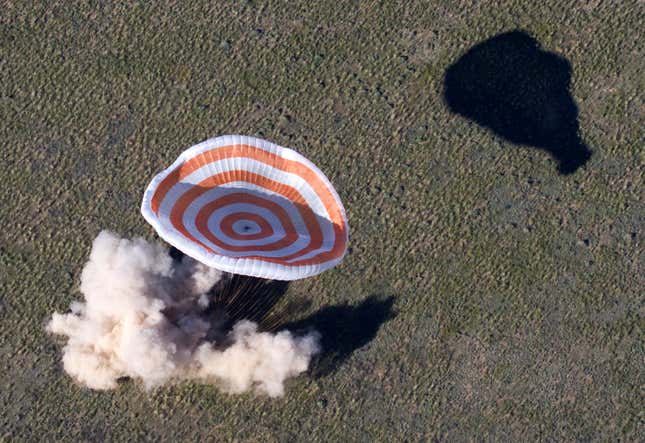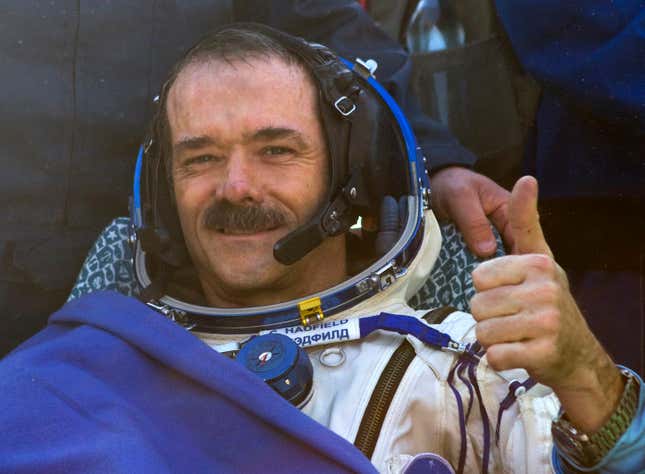Chris Hadfield’s days of space travel are behind him, but he’s still whizzing by at the speed of light.
“I think it’s the fifth time I’ve ever retired actually,” he tells Quartz. “I used to be a downhill ski racer, then I was a farmer, then I was a fighter pilot, then I was a test pilot, then I was an astronaut. Now I’m a university professor, and author, and speaker, and musician, and it keeps me busy. To me, I’m just doing what next.”

The Canadian astronaut announced his retirement in 2013 shortly after he touched down on earth from space for the last time. As commander of the International Space Station, he oversaw a record number of science experiments and an emergency space walk the eve of his scheduled departure to earth. But what most people will remember him for is his cover of David Bowie’s “Space Oddity”—performed in zero gravity. The video has amassed 26.6 million views on YouTube and counting.
Stopping in San Francisco this week, he sat down with Quartz to talk about the secret to overcoming fear, his aspiration to travel to Mars, and the challenge of putting on shoes in space. (This transcript has been edited for length and clarity.)
What’s the clumsiest thing you’ve had to do in space?
At first, you’re clumsy at everything. Oddly, the clumsiest things are anything that take three of your limbs.
You have to have at least one hand, or maybe two feet to keep your body stable. So if you’re trying to put on your running shoes to use the treadmill—putting on a running shoe takes two hands and one foot—there is nothing to hold you. I’ve tried for five months to become elegant at putting on my running shoes.
I’d take my running shoes and float freely in space, and I’d get myself stable and try with one foot—you end up just sort of bobbing around like balloon that’s tied by a string. It just made me laugh every time. You would never put on a running shoe while riding a unicycle. That’s what it’s like in space.

In your book, you write that you weren’t sure you’d ever go to space again after your 1995 flight. And yet you kept training. How do you stay motivated when the possibility of space flight is so narrow?
The real key is to define your own threshold for victory.
If you’re an Olympic athlete, if your only measure of success is to win a gold medal, you have set yourself up for a miserable life.
Don’t wait for some imaginary, impossible distance line to celebrate success. Celebrate it all the time, and maybe you’ll also win a gold medal. But don’t blow it out of proportion of your own life.

According to your book, one way of preparing for spaceflight was the ”death simulation.” In it, you and your family had to think through all the contingencies of you dying in space. What is that like?
The more dramatic the event, the more important it is to have prepared for it, I think: If the news is negative, who are you going to phone first? Who are you going to phone second? How long are you going to stay in Houston before you move back to Canada? Where are you going to move to in Canada? Are you going to sell the house here? Are you going to buy a house? What’s our insurance cover for this?
My wife was planning to hike the Himalayas, but when we went through the death simulation, [she thought]:
If I’m in the Himalayas and something goes wrong up there, what I’m doing is absolving my responsibility as a member of this family. The media’s going to be at the house within 30 minutes if something’s gone wrong in the station, and if I’m not there, they’re going to each of the kids around the world. We’re not going to be able to talk to each other, and it’s going to be a disaster.
So she had to be in North America during my whole flight, just in case. That was a direct product of going through a simulation, because she hadn’t really thought about it.
Isn’t that grim?
I view it as necessary—no, positive. Most people live in fear, because they would rather not face up to the most probable things to go wrong. So instead of feeling calm and confident with the plan, instead they go around with this knot in their stomachs, fingers crossed, hoping bad thing don’t happen. But bad things happen all the time.
So why go around with stress and worry? Why do it? You don’t have to. It’s totally up to you. Give yourself a plan and then practice dealing with it.
What are your thoughts about the privatized space business? Do you believe that is what’s needed to push the frontiers of space travel?
Space flight’s always been privatized depending on what your definition is. Every spaceship was built for profit by a private company.
People look at Elon Musk and SpaceX as if it’s some crazy off-the-wall thing, but they get billions in dollars from the US government to build hardware, just like Boeing, just like Lockheed Martin—there’s no difference. The real key is this: At what point does the cost get low enough that an individual or an individual company can buy it from another individual company with no government in the way?
We got over that threshold for unmanned space flight decades ago. A private company can build a satellite, put it on a private rocket, and launch it with no government subsidization, but we’re not there with people yet.
But eventually we will be, and there’s nothing wrong with that. That’s how it’s happened in luxury sea travel, that’s how it’s happened in air travel, and eventually it’ll happen in space travel.
Chris Hadfield’s autobiography, An Astronaut’s Guide to Life on Earth, was published in October 2013.
